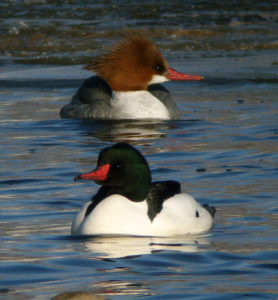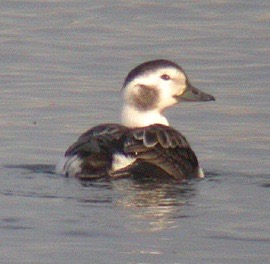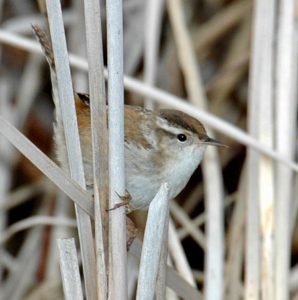On Saturday we visited two main destinations. We started at South Platte Reservoir, famous in the local birding community for having a county line bisect it thus providing a potential opportunity to see whatever waterfowl are present in both Jefferson and Arapahoe Counties – that is if said waterfowl cooperate and swim from one side of the reservoir to the other. County listing has become quite the recreational sport, and instead of just “seeing” birds, the focus is to “get” them, i.e. be able to enter them on a specific list or lists (county, state, country, month, year, etc.). A few of us don’t play this game as vigorously as others. Our second destination was the four “lakes” (AKA old gravel pits) immediately north of C-470 along the South Platte River – Blackrock, Eaglewatch, Redtail, and Bufflehead Lakes. This general area is a favorite destination and often has great birds.
We had two uncommon sightings from the dike surrounding South Platte Reservoir. First, a pair of Long-tailed Ducks was seen, but only at a distance so the views were not great. This duck was formerly known as Oldsquaw in North America, but in 2000 the American Ornithologists’ Union changed the name to Long-tailed Duck, the name by which it is known in Europe. It is primarily circumboreal in its distribution, breeding in the arctic, but with a few wandering south to the lower forty-eight each winter, primarily to New England and the Great Lakes region, but we’re fortunate to get some here in Colorado.
Our second good sighting from up on the dike was of a Harlan’s Red-tailed Hawk. There are about 12 subspecies of Red-tails, adding a lot of fun to trying to properly identify them. Harlan’s is among the darkest of these subspecies, being primarily black with a dusky white tail that lacks any hint of red. They have a characteristic white streaking on the breast that can be helpful in their identification. One of the real keys when seeing a bird in flight, as we did, is to be able to first identify it as a Red-tail, and its overall silhouette is a major key. Red-tails, compared to other soaring hawks (the Buteos) are stocky, broad-winged even out to the tips of their wings (not pointed), and a real key is that they have bulging secondaries – that is the wing is widest where the secondary feathers are. Once you have narrowed your soaring hawk down to it being a Red-tail, then you can start tuning in to which subspecies it might be. One interesting aspect of Harlan’s is that about 99% of them are dark morph. Almost all the other subspecies are only about 10% dark morph. Get your field guides out and see if you can see what I’m talking about here. Locally, our most common Red-tail is the light morph of the Western subspecies (Buteo jamaicensis calurus), noted for its pale breast, streaked belly band, white spotting on its scapulars, dark head, dark chin, and adults with a red tail. Finally, one last characteristic to be aware of is that ALLRed-tails have a dark patagial bar – the leading edge of the wing. It’s less obvious in some subspecies than others, but it’s there.
Our third great bird of the morning was a Marsh Wren. These wrens breed in cattail marshes and have been recorded every month of the year in Colorado, though they are more uncommon in winter. Their pattern of residency is a bit of a puzzle: some marshes have breeders, many evidently suitable marshes never have breeders, other marshes only have Marsh Wrens in the winter, and other sites have birds all year long. Here’s a gross generalization – Most large marshes which tend to remain unfrozen throughout the winter generally will have some wintering populations, but there are no guarantees.
Hope you are planning on having fun participating in one of Colorado’s fifty Christmas Bird Counts!
Chuck
South Platte Park, Dec 7, 2019
31 species
| Canada Goose | 7 |
| Northern Shoveler | 460 |
| Gadwall | 18 |
| Mallard | 14 |
| Green-winged Teal | 4 |
| Ring-necked Duck | 18 |
| Lesser Scaup | 11 |
| Long-tailed Duck | 2 |
| Bufflehead | 38 |
| Common Goldeneye | 25 |
| Hooded Merganser | 31 |
| Common Merganser | 12 |
| Ruddy Duck | 13 |
| Pied-billed Grebe | 2 |
| Eared Grebe | 1 |
| Rock Pigeon | 18 |
| American Coot | 15 |
| Ring-billed Gull | 15 |
| Bald Eagle | 1 |
| Red-tailed Hawk | 2 |
| Harlan’s Red-tailed Haw | 1 |
| Belted Kingfisher | 3 |
| Downy Woodpecker | 1 |
| Northern Flicker | 3 |
| American Kestrel | 1 |
| Blue Jay | 1 |
| Black-billed Magpie | 1 |
| American Crow | 2 |
| Marsh Wren | 1 |
| European Starling | 1 |
| American Robin | 1 |
| American Goldfinch | 1 |






Comments
Write Comment